The simplicity and purity of the master’s violin concertos belie their great technical and musical demands. Violinist Nikolaj Szeps-Znaider delves beneath the surface, in this article from August 2006
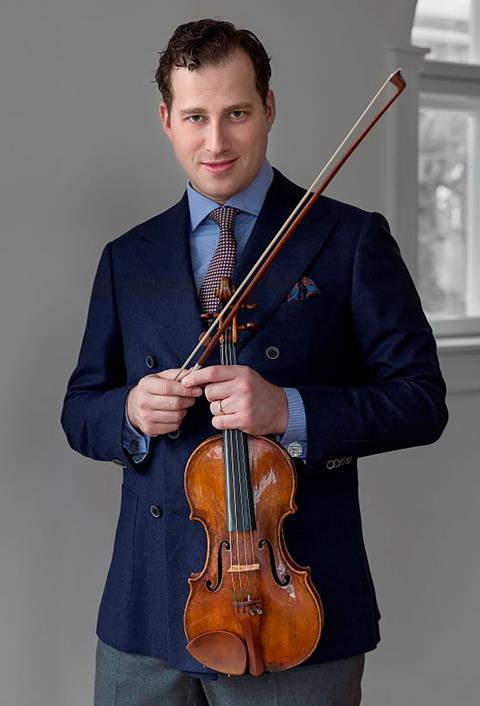
There is something that you cannot explain about Mozart – some kind of divine vein that he was able to tap into. With Beethoven it is as if he speaks to the heavens, but for Mozart it is the other way round; something is coming down upon us from somewhere else. The way to understand him is through his operas; his music is about characters. For us as violinists, the challenge is to embody several clearly defined voices, even though we only ever play one line: the sense of polyphony within monophony.
This is a marvellous piece. It’s early Mozart, but very beautiful and eloquent. The first thing to consider when you approach the first movement is that, unusually, the main orchestral exposition (Allegro aperto) is interrupted by a seemingly unrelated solo adagio, preceding the main solo movement (the second Allegro aperto). What is the relationship between the tempo of the Adagio and the tempo of the main movement? It’s important to ask this question rather than having a fatalistic approach whereby you start without thinking about it. The tempo of the main movement is determined by that of the Adagio, and not the other way round – there must be some sort of connection. For me, the Adagio is half the tempo of the allegro, so if the Adagio is not to be too fast, the main tempo should be somewhat held. This way of thinking gives the music sense, proportion and an organic quality.
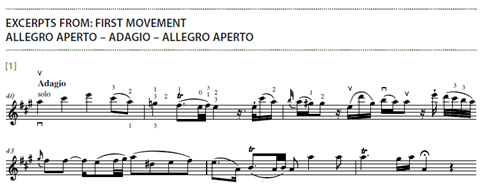
The main priority in the opening of the Adagio is to make sure that the notes are well connected, particularly the A to the C sharp, as you’re all alone. This requires smooth bow changes; the bow speed at the beginning of the C sharp should not be faster than at the end of the A, otherwise there will be an emphasis on the beginning of the note. Practise the first three notes in one bow, at the right tempo. You’ll never play it this way, but it will train your ear to want to hear it completely connected rather than as three separate notes. The vibrato has to be uninterrupted too, so when you do this exercise, make sure that the speed of the vibrato does not vary when you change fingers. One can also practise simple scales like this, in which you set each finger down without creating a new impulse, giving you a continuous vibrato.
Some people prefer to start the Adagio on an up bow because they find it uncomfortable to start softly alone on a down bow. If you do start on an up bow, I would stay on the E string. This works if you phrase to the F-sharp trill, which comes out on a down bow, and I would start the trill from the G. Or you can start on a down bow and phrase to the G natural (on the A string), which works out on a down bow; I think this makes more sense. In this case I would start the trill from the F sharp.
There shouldn’t be anything rigid about fingerings. The left hand should remain sensitive and intelligent throughout the choices we make. There are certain principles, however. For example, I wouldn’t change string in a place where it might ruin the phrase – it would be like changing the tone of your voice before you’ve finished a sentence. Also, when playing repeated notes never use the same finger twice: always change so that you get a different articulation with the new finger. For example with the G sharps in bar 42, even if you change bow you won’t get the sense of articulation of a singer unless you change finger.
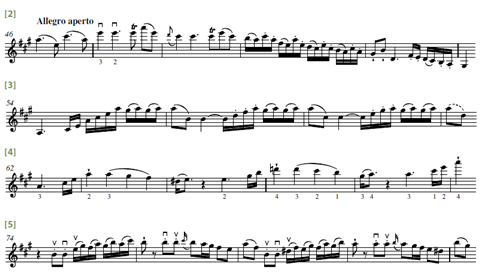
At the start of the main Allegro, we’re accompanying the orchestra, duelling with its arpeggio theme. This is an uncomfortable place, high on the E string, and you have to get down quickly, so first I would find a fingering. I stretch to the third finger on the first E of the second bar and then move to the second finger (again, on the principle of not playing repeated notes on the same finger). Because it is the same musical material as the adagio, the notes should be given the same relative importance, so I would do a down bow on the first note of the bar rather than an up, otherwise it loses that connection. All these technical decisions should be made for musical reasons; we should never do something because it’s comfortable.
In the groups of semiquavers starting from bar 49 and throughout, it’s important not to try to make the bow jump; give it the right conditions and it will jump by itself. If you play with little bow and keep the stick right over the hair, it will work; make sure you apply pressure rather than trying to take it away. The converse of this is if you get bow shakes; you can combat this by turning the bow on the side of the hair and making it non-parallel with the bridge, to stop it from shaking. Make sure to vibrate the legato notes of these groups, so that it doesn’t sound like an exercise.
With the phrase whose shape repeats from bar 54, it’s worth remembering that repetition is a form of insistence (example 3). There are different ways of being insistent; you can say something louder each time, or you can become softer – the main point is that it’s never the same. Here you can either play more and more each time, or you can play the third one less, making it more elegant.
From bar 62 we have more repetition, with three statements of a phrase-shape, the third of which is used as a stepping stone from which Mozart generates further activity (example 4). A lot of violinists like to play the third one on the E string, but it can become a bit exhibitionistic if you do this; it suddenly sounds very virtuosic and in the wrong style. I would use the same interrelation between the two strings as in the previous two arpeggio figures, playing the lower octave on the A string and the top one on the E.
In bar 74 make sure that the two quavers are well articulated and that the phrase has a sense of direction (example 5). When you have two slurred notes of the same length in Mozart, as here, the second is always less. This is not easy to do in tempo, so practise it slowly. When you slow it down, play it proportionally, phrasing the same way as you would if you were to play it in tempo. What you practise is what you end up playing so if you practise it mechanically and detach it from your music making, then you will perform it mechanically. It is important to practise slowly and to be honest with yourself about what you are actually hearing. This is not always pleasant, but it’s much better that you hear it and correct it than that otherpeople notice it, because they will!
From bar 74 we clearly have two different voices alternating (and from bar 78 another one – the orchestra). To characterise them I play the second-beat quavers in bars 74 and 76 slightly long, starting up bow in the upper half, almost in the string, like martelé. The ones in bars 75 and 77 are shorter, and I start with a down bow in the lower half, although not everybody likes playing them in different parts of the bow like this. Take an imaginary breath in the quaver rest, but without taking time. The repetition in bar 76 might be louder, as it is insisting.
Read: ‘If you had told me a year ago…I would have dismissed it as impossible’ – Nikolaj Szeps-Znaider
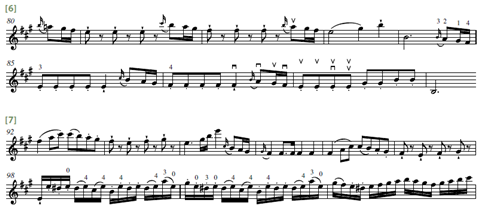
From the end of bar 80 I phrase to the first E of bar 81 and then through bar 82 towards the E in bar 83, although there is not one single right way to do it (example 6). The conductor Josef Krips once said: ‘Mozart can be either plebeian or aristocratic, but never bureaucratic.’ It’s a wonderful quote, and here is a case in point; I would play from the end of bar 80 to bar 84 in an aristocratic manner and from the end of bar 84 in a more plebeian, folksy style. In order to the get this latter character, I go into third position and use the G string for the repeated notes.
The conductor Josef Krips once said:‘Mozart can be either plebeian or aristocratic, but never bureaucratic’
From bar 92 it’s as if there’s a conflict between the sustained notes, which are someone being very emotional, and the short ones, with which someone else is waving a warning finger (example 7). It’s important that the short notes don’t rush, which is a typical mistake; it’s a little uncomfortable so one makes the rests shorter than they should be. This is a matter of really holding the bow – many people just put the bow on the string and push it back and forth rather than actually leading it. There should be a lot of motion in all the right-hand fingers: this bow control is the tool that enables you to realise all these musical ideas.
I feel that Mozart doesn’t tolerate too wide or fast a vibrato. Generally you can play without it as a colour, for effect, but I would vibrate every note unless making such a specific musical point. For example, if you stop vibrating the note before an important note that you want to be very warm, you emphasise that note by contrast. And even if it’s not a real vibrato, if the last joint of the finger gives in when you push the finger down, without the hand moving, this give the sounds some life. But how we really want to vibrate at the beginning of a note; whether we want it to open up; whether we should use an even vibrato from note to note – these are the important questions that we must ask ourselves. At bar 98, despite all the notes, you should be with the orchestra on the first and third beats and their up-beats; so what happens in between is less important, although with imagination you can play around with it
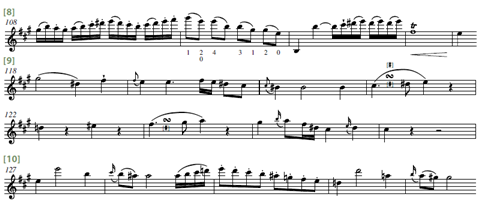
When you have a figure such as that at bar 108, remember to open out the elbow, keeping the bow parallel to the bridge, and use more bow with the crescendo (example 8). Mozart only ever writes the crescendo very late in the orchestral score, so even if you do become a little louder at bar 109, it isn’t forte yet – save some- thing for the end of the trill.
The development section, which starts at bar 118, is interesting because it contains material that we haven’t heard yet (example 9). It reminds me more of the development section of the Third Violin Concerto than it does of anything here; it’s a rhythmic quotation. Again, you have different characters: the lyrical one from bar 118 has to be completely contrasted with the staccato of the preceding bars in the orchestra. Once more, it is a quasi-struggle between short and long, or masculine and feminine. When the music becomes more complex harmonically and dramatically, with more tension, such as at bars 122–3, it demands a little time and flexibility, but when it resolves in the next bar, let it go, without rhythmic resistance.
Read: Masterclass: Ray Chen on Mozart Violin Concerto no.3
Read: ‘A feeling of waves and lightness’ - Francesca Dego on performing Mozart Violin Concerto no.4
In bar 130 the cellos and basses come in with an F natural (example 10). I would play less here, because harmonically we are far from home, which causes a feeling of disorientation. Often in development sections the main theme is reworked in various keys and it never feels right, because it’s in the wrong key. Subconsciously, the ear hears that it is not at home. It is a relief to return to the A major tonic at bar 144, because the music has gone through so many things, including the peculiar modulation to C sharp minor. So the theme at bar 144 can never be the same as at bar 46 because of everything we’ve been through in between. It’s our respon- sibility to know this and to make decisions that make sense of such connections.
Music is something that goes through this process of ‘becoming’ and, depending on how the people on stage with me are playing, it will ‘become’ in a certain, unique way in every performance. Everyone loves chamber music because it involves this interaction. Music is never something with which we try to achieve a certain result and then try to repeat it in perpetuity – we should always aim to be reactive.
Most people who have a gift for music know how to shape a single phrase; but how to connect it and make it organic with what came before and what comes after is the biggest challenge. That’s what I think about while I play. If I think, ‘Ah, the flute did that,’ I react in a certain way. But if you don’t know the piece in great detail then this interaction won’t mean anything; in effect, you will only have learnt part of the work. This is our responsibility as performers.
When we succeed, people come out of a concert having experienced something that they know has changed them. The only way to achieve this is to understand the connections in the music, not just within the composition itself, but how this particular piece relates to the other works of Mozart (especially the operas); how it relates to music history, philosophy, the time in which it was written and anything else you can bring into it. When we realise these things, music has a relevance that the audience feels instinctively; it feels that something significant is being said.
INTERVIEW BY ARIANE TODES











































No comments yet